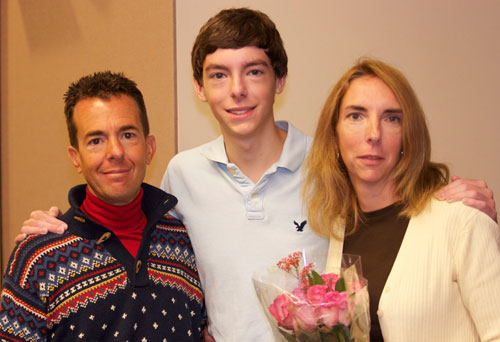Special guests make Stroke Education Conference memorable


The case study of Pamela Simon was on the agenda at the 11th Annual Stroke Education Conference, Oct. 13, at Christiana Care. Simon suffered a stroke six months ago. Today she is active and well — and she came to the conference with her husband Brian and son Jake to prove it.
Jorge Vasquez, an EMT-paramedic, first saw Simon when he responded to a 911 call at 6:48 a.m. to help a woman slumped at her breakfast table. The patient was 44 years old and healthy, except for a recent virus, which gave her a bad cough and violent retching.
“She couldn’t talk with us and was getting upset,” Vasquez said.
Simon was rushed to Christiana Hospital, where a stroke team was poised to spring into action. Michael Carunchio, M.D., a neurologist, noted that Simon was paralyzed on her right side. She suffered from facial droop, and her pupils were not the same size.
Doctors had an important decision to make: Should they administer tissue plasminogen activator, commonly known as tPA? This enzyme is found naturally in the body, and it converts plasminogen into another enzyme to dissolve a blood clot. It’s an important tool in treating stroke patients. It may also be used in an IV site by doctors to speed up dissolving of a clot.
But tPA is not without risk, because it raises the odds of bleeding in the brain.
Optimally, tPA should be given within three hours of the onset of a stroke, and Simon was well within that window of time. On the National Institutes of Health stroke scale — a measure of 11 factors — her score was a 28, which is considered a severe stroke, yet within guidelines for tPA.
“After much discussion, we all favored administering tPA,” Dr. Carunchio said.
The process takes about an hour, said Donna Lougheed, RN, a nurse on the stroke team. During that time, Simon’s family was with her to comfort and support her.
After the tPA infusion, Simon was immediately transferred to the interventional lab, where Gregg Zoarski, M.D., a neurointerventional surgeon, and his colleague, Barbara Albani, M.D., used tiny wires to break up a clot in her brain and vacuum it away. They also placed a stent in Simon’s carotid artery to restore blood flow to her brain.
“Flow is your friend,” Dr. Zoarski said.
The procedure was a success, and Simon recovered rapidly, undergoing rehabilitation therapies to help regain her strength, mobility and speech. Six months later, her stroke score is 1, due to slight problems with her speech.
At the conference, she provided feedback to the audience of health professionals about her experience as a patient. “I feel good. I am happy,” she said.
Her husband, Brian, added, “Thank you, Christiana Care. Without you, Pam wouldn’t be here today.”
The conference was sponsored by the Delaware Stroke Initiative, the Medical Society of Delaware and the Delaware Academy of Medicine. Other topics included intracranial aneurysms and stroke prevention.